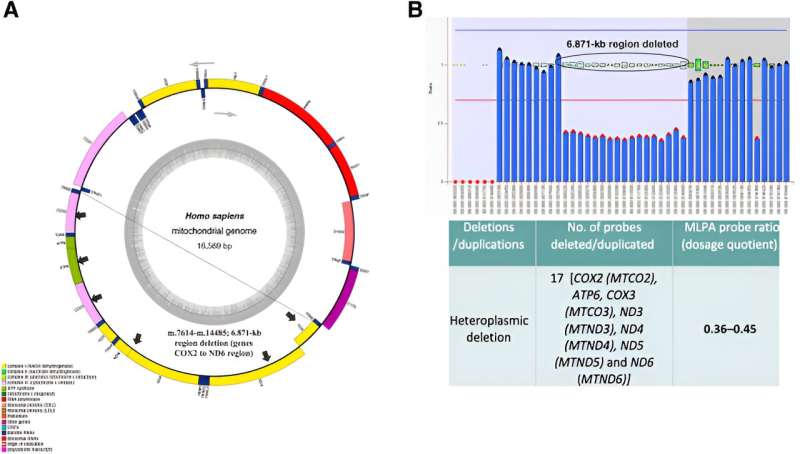This article has been reviewed according to Science X's editorial process and policies. Editors have highlighted the following attributes while ensuring the content's credibility:
fact-checked
peer-reviewed publication
trusted source
proofread
Study highlights importance of screening for rare inherited iron metabolism defects

Over 40% of cases curated based on stringent clinical and laboratory criteria from the Indian subcontinent have an inherited iron metabolism defect on comprehensive genomic evaluation, report investigators in The Journal of Molecular Diagnostics.
Although iron deficiency anemia is the most prevalent form of anemia globally, it may be underdiagnosed due to lack of awareness or methodical screening. Investigators who systematically evaluated anemia cases based on stringent clinical and laboratory criteria between 2019 to 2021 in the Indian subcontinent, which has an iron-deficient endemic population, have uncovered an inherited iron defect in 41% of cases, highlighting the need for active screening and awareness.
Co-lead investigators Prateek Bhatia, MD, Amita Trehan, MD, and Pankaj Sharma, Ph.D., Pediatric Haematology Oncology Unit, Postgraduate Institute of Medical Education and Research, Chandigarh, India, explain, "Iron deficiency anemia affects 30–40% of children aged 2–5 years in India. With such high frequency, clinicians in outpatient departments, especially in peripheral health care facilities, end up prescribing oral iron to any child presenting with microcytic hypochromic anemia upfront without systematic evaluation of a basic iron profile.
"When the response to this treatment is suboptimal or absent, they are unsure how to proceed. In addition, they are puzzled when they encounter a case with anemia and abnormal iron profile suggestive of iron overload without secondary evidence of hemolytic disease or hemoglobinopathy on screening."
The lead investigators continue, "Our aim was to address these gaps by designing a study to assess whether we are missing or underdiagnosing inherited iron metabolism defects in our iron-deficient endemic population and design a systematic work-up algorithm based on available literature and studies to help spread awareness among clinicians in our region about structured laboratory and genomic testing in such scenarios."
Investigators systematically evaluated close to 300 anemia cases from 2019 to 2021. Following stringent and structured case selection criteria, the researchers excluded patients diagnosed with common conditions of iron deficiency, hemoglobinopathy, inflammation, celiac disease or chronic bleeding from the study. This process resulted in a cohort of 41 cases of suspected sideroblastic or nonsideroblastic iron defects.
Sideroblastic anemia results from abnormal utilization of iron during the production of red blood cells with resultant entrapment of iron in the mitochondria of developing erythroid cells in bone marrow. Nonsideroblastic iron defects have a block in iron utilization during transport or reduction in the cells.
Next comprehensive, step-wise genomic testing starting with a targeted iron panel–based next-generation sequencing (NGS) was followed by subjecting negative cases to whole exome sequencing and mitochondrial genome copy number alterations and sequencing and chromosomal microarray. This strategy helped them identify a myriad of rare congenital sideroblastic anemias as well as a few nonsideroblastic iron defects with pathogenic gene mutations.
Dr. Bhatia notes, "The systematic evaluation of anemia cases from our high iron deficient endemic population, based on clinical criteria and basic and advanced genomic tests, helped us uncover an inherited iron defect in a selected 41% (17/41) of cases, suggesting the need for active screening and awareness for these rare diseases in our population."
Investigators were surprised to find many of the rare sideroblastic gene defects in the cohort presenting either in late childhood or adulthood or being undiagnosed. They were also surprised to find a different novel yet recurrent mutation in SLC25A38 gene in unrelated patients from the northern part of the country, suggesting an ethnically diverse population in the subcontinent.
Dr. Sharma adds, "With the study results, an awareness among clinicians in our centers and other parts of the country is bound to increase and help them identify these rare genetic disorders in their day-to-day clinical practice as per the systematic enrollment and testing algorithm. This will also immensely help to avoid delays in getting a possible diagnosis in children suspected to have such defects and reduce the burden of other unwarranted or unnecessary tests in these cases."
Dr. Trehan concludes, "This research is particularly important at this time to help reduce the burden of rare inherited defects in our country, devise strategies to identify the target at risk population for screening, and provide options for novel therapeutics or timely stem cell transplant."
In an accompanying Commentary, F.N.U. Alnoor, MD, Department of Pathology and Immunology, Washington University, and Robert S. Ohgami, MD, Ph.D., University of Utah and ARUP Laboratories, emphasize that just because a disease is rare, it does not mean it is not important to study and be the focus of clinical attention.
They write, "The significance of these findings for the field of iron metabolism and anemia is clear. This research not only adds important details to specific genes via functional analyses, which are much harder types of data to come by, but also adds to a growing body of evidence highlighting the genetic heterogeneity underlying iron metabolism disorders.
"By linking specific genetic variants with disruptions in iron homeostasis, the study adds to our understanding of the molecular mechanisms of anemia, paving the way for precision medicine approaches to treatment."
The impact of inherited iron metabolism defects on public health is substantial, contributing to morbidity, reduced quality of life, and increased health care costs. They are characterized by a deficiency in iron availability, leading to impaired hemoglobin synthesis. Causes range from dietary insufficiency and chronic blood loss to genetic susceptibility.
More information: Pankaj Sharma et al, Comprehensive Genomic Analysis Identifies a Diverse Landscape of Sideroblastic and Nonsideroblastic Iron-Related Anemias with Novel and Pathogenic Variants in an Iron-Deficient Endemic Setting, The Journal of Molecular Diagnostics (2024). DOI: 10.1016/j.jmoldx.2024.01.011
FNU Alnoor et al, Deconvoluting the Complexity of Congenital Sideroblastic Anemias through Genetic and Functional Profiling, The Journal of Molecular Diagnostics (2024). DOI: 10.1016/j.jmoldx.2024.03.002



















